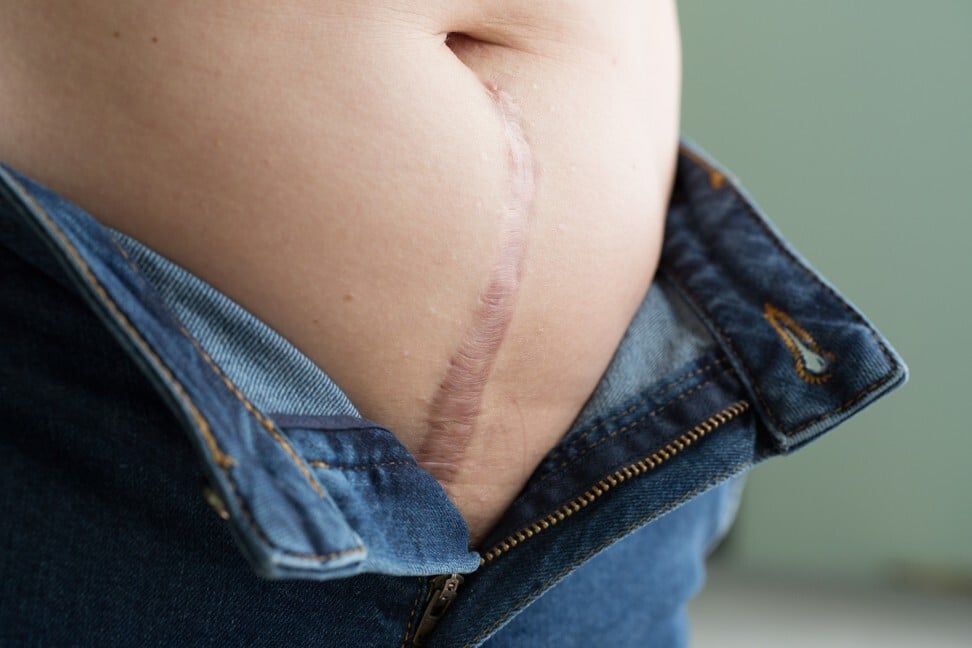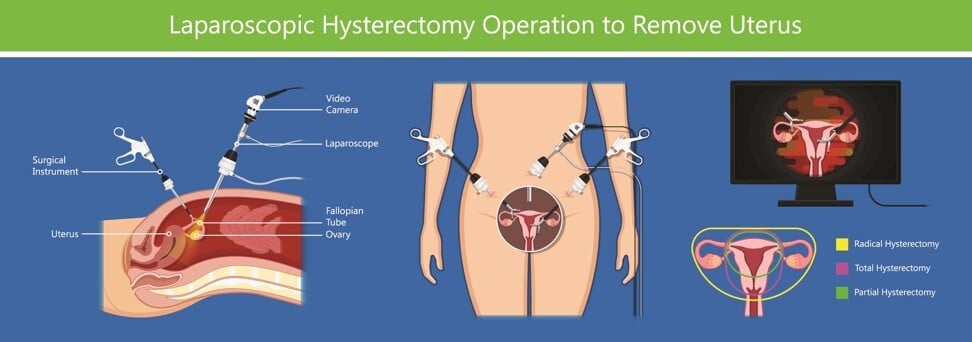
No more pain and tiny scars: how a laparoscopic hysterectomy gives women their lives back
- An operation to remove a uterus, a laparoscopic hysterectomy has a fast recovery time and minimal scarring. That’s why Karen Angel sought one out
- As she writes, she found widespread ignorance about the procedure among doctors. She talks to a woman whose life, like hers, was changed by the keyhole surgery
After five years and eight doctors’ opinions, I finally found a surgeon who said she could remove my problematic uterus using keyhole surgery.
At 1.3kg (2.9 pounds), my uterus, which typically resembles an upside-down pear, was fibroid-laden and had grown to 10 times normal size. I looked about seven months’ pregnant.
The fibroids were non-cancerous and didn’t cause painful symptoms, so my long-time gynaecologist advocated a wait-and-see approach. Unfortunately, over the years of waiting and seeing, my uterus grew too large for all but the most specialised and skilled surgeons to remove.
A hysterectomy is the operation to remove all or part of the uterus. It is commonly done in an open operation in which a surgeon makes a 13cm to 18cm (5-inch to 7-inch) long incision across the abdomen, through which the uterus is removed. Keyhole surgery, also known as laparoscopy, is a minimally invasive operation performed in the abdomen or pelvis using small incisions with the aid of a camera called a laparoscope.

“Many ob-gyns are not even familiar with all the options available,” says Dr Erica Stockwell, a gynaecological surgeon in Orlando, Florida, who says that many patients are often not given all the options. “I could go on and on and on about this.”
So could I.
Knee surgery ends years of pain – and gets patient back on her feet
Doctors I saw in the Hudson Valley region of New York, where I moved nine years ago, seemed stunningly ignorant about minimally invasive treatment options.
There were also disappointing doctor visits in New York City. A robotic surgery specialist I saw at NYU Langone told me – erroneously, I later discovered – that my uterus was so wide there was no room in my abdominal cavity for the surgical instruments.
A surgeon I saw at Montefiore Medical Centre told me she could remove my uterus via a small bikini-line incision. It was still open abdominal surgery with all the attendant risks and longer recovery time, so I kept looking. Neither she nor the NYU surgeon offered a referral, nor did she mention – as I later discovered – that she has a colleague who routinely performs laparoscopic hysterectomies on enlarged uteruses with great success.

“We teach that referral should always be offered if a doctor is not capable of performing a needed or desired medical procedure,” says Dr Louise King, an assistant professor of obstetrics, gynaecology, and reproductive biology at Harvard Medical School in Boston, who teaches a course on informed decision-making. “I can’t imagine another ethical option.”
Dr King often sees patients with severe disease or who have had botched operations that would have been much easier to treat or correct if they had been referred to her earlier. She believes that many gynaecologists operate infrequently and aren’t well-versed in advanced surgical techniques because reimbursement rates for gynaecological surgery are comparatively low.
Her advice: seek out a gynaecological surgeon who has done a two-year minimally invasive surgery fellowship or has a high volume of surgery.

Sixty per cent of these hysterectomies are performed through a large abdominal incision, although the operation carries a higher risk of complications, more post-operative pain, and a longer hospital stay and recovery period than other, less invasive procedures.
“Minimally invasive approaches to hysterectomy (vaginal or laparoscopic, including robot-assisted laparoscopy) should be performed, whenever feasible, based on their well-documented advantages over abdominal hysterectomy,” the American College of Obstetricians and Gynaecologists writes in its clinical guidance.
Period pain: what it is, its causes and what you can do to alleviate it
When I voiced dissatisfaction with the first Montefiore surgeon, who I felt didn’t give me complete answers to my questions, the vice-chair of the hospital’s gynaecology department recommended Dr Holly Yettaw Luts. I had resigned myself to having abdominal surgery when she was examining me and casually announced, “I think I can do this laparoscopically. I’ve done bigger uteruses than yours that way.”
Far from a disfiguring scar, I have a few small, fading marks on my abdomen where the camera and instruments were inserted and the tissue removed.


Roxanne Gracyalny, a 45-year-old human resources director from Albion, Illinois, who also underwent this procedure, has only two small marks on either side of her belly button. She had been reluctant to have surgery because she had seen her mother suffer from pain and scarring after an abdominal hysterectomy. So Gracyalny endured heavy periods and horrible cramping for decades.
Her fibroids became so large and her symptoms so severe that in 2017, she was referred to a minimally invasive specialist, Dr Allan Adajar.
The change in her life is astounding. “I would have one week a month where I was miserable, and then I wasn’t having any weeks like that. It’s such a freeing feeling,” says Gracyalny.
Like me, she urges women to seek treatment if their uteruses are making them miserable: “I think sometimes women feel tied down to this, and they don’t have to be.”
Amen, sister. Just kiss that monstrous uterus goodbye. The right doctor for you is out there somewhere.

